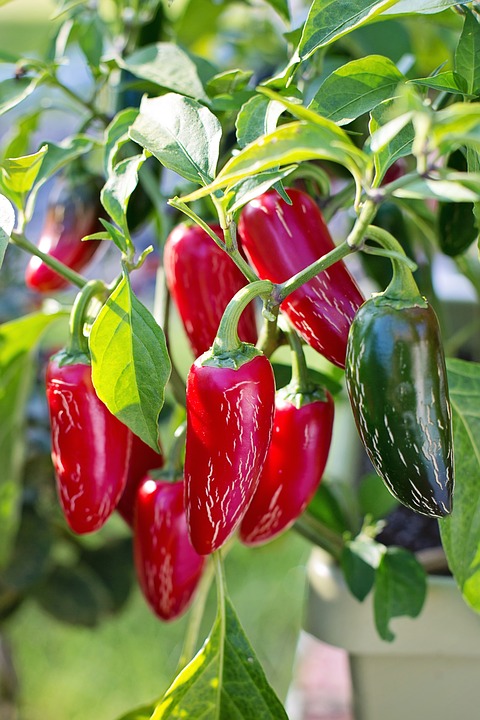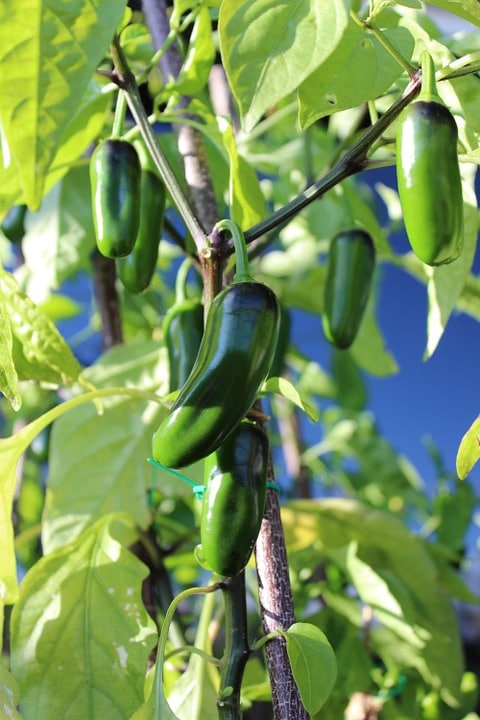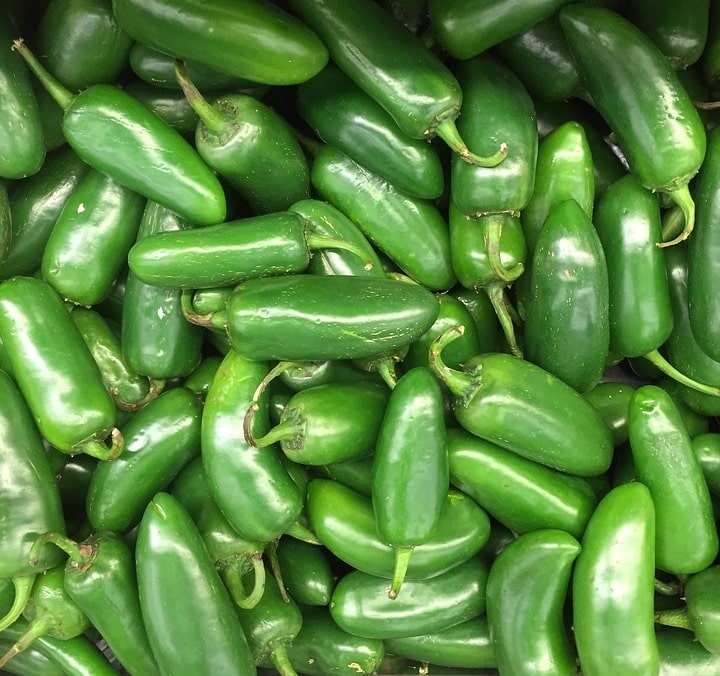Growing jalapenos at home – A step by step guide
What are Jalapenos? Jalapenos are very spicy chili peppers from the hot pepper family. Jalapeno peppers are a good supply of vitamin C, folate and vitamin A. Jalapenos are low fat, saturated fat-free, cholesterol free, and sodium free. These plants can be grown just like any other chilli or capsicum plants. We can discuss now with jalapenos planting, caring, and harvesting as part of growing jalapenos at home.
Facts about growing jalapenos at home:

- Jalapenos are semi-tropical plants which are usually grown as annuals. Generally, Jalapeño plants cannot survive in heavy winters as cold temperatures are the main cause of plant death (Jalapenos plants cannot survive to frost conditions).
- Jalapenos require soil that drains well but is evenly and consistently moist. When watered, the soil should be moistened to a depth of six inches below its surface. You can experiment moisture by sticking the tip of a pencil into the ground around the pepper.
- Jalapenos are sun-lovers that require long days to set fruit. Locate them in a spot in the garden where they get full sun requirement.
- Jalapeno peppers (Capsicum annum) rank as among the most common and generally grown of hot pepper varieties.
- Jalapeno peppers grow almost anywhere as tender garden annuals. Start plants indoors from seed for planting outdoors later or maintain plant indoors as it matures.
- Jalapeno peppers that produce in temperatures between 80°F to 90°F degrees yield maximum fruit. A standard 10-10-10 NPK fertilizer can be used to feed plants.
- Jalapeno pepper plants grow 24 inches to 30 inches tall and16 to 18 inches wide. Space the plants 12 inches to 18 inches apart in full sun. All Jalapeno pepper plants belong to the same species and can cross-pollinate. Plant special types of peppers at least 50 feet apart if you plan to harvest seeds for replanting.
- Jalapenos require long hours of sunlight to grow and prefer a southern exposure where soil warms up quickly. They need at least 6 hours of sun per day to grow properly. “They flower and set fruit best when days are eight to twelve hours long,” advises Doug Dudgeon of Brooklyn Botanical Garden.
- Jalapenos can be grown totally in the greenhouse or raised to transplant size. Greenhouse-grown jalapenos need at least 13 hours of light and 16 hours of light is ideal.
- Trim jalapeno plants at the end of summer or early fall to extend pepper development until your area’s first killing frost. Remove suckers, or the thin stems growing between 2 larger stems. When you eliminate suckers, the plant puts more energy into pepper production.
- If jalapeno plants are NOT growing, then there is an issue with soil fertility or any pest and disease attack.
- The life cycle of jalapeno plants is similar to any other capsicum related plants in terms of germination, plant growth stages, pollination of the plant, fruiting time period and ripening stage.
- Most of the hot peppers like jalapeno take 4 to 5 months to mature the fruits after transplanting. However, it is better to refer to a seed package.
- Each Jalapenos plant can produce 20 to 30 pods per plant depending on the variety.
- Usually, Jalapeno seeds germinate after 12 to 14 days of sowing.
- Usually, Jalapeno seeds are planted indoors pots/containers, 6 to 7 weeks before the last expected frost.
- You can plant Carrots, Asparagus, Cucumbers, Squash, and Eggplants along with Jalapenos in your backyard as companion plants.
- If you are buying jalapeños from the grocery store or vegetable market, they won’t come true type from seed as they are mostly hybrid types.
- Growing jalapenos in indoors are similar to growing outdoors, balconies, terrace, and backyards.
You may also read the Growing Tomatoes from Seeds.
Keeping the jalapeno indoors

Start the jalapeno pepper from seed at any time, since you’re not limited by freezing weather. Use the heating pad and daylight quality lights to obtain the amount of light and soil temperatures needed.
Transfer the sprouted seedlings to larger pots as they produce, aiming at a finished size of a 2-gallon or 5-gallon pot for a mature jalapeno plant, which can reach a size of two to three feet tall.
Fertilize the plant with a balanced fertilizer every 3 weeks or incorporate controlled-release fertilizer into the soil with each transplant. Utilize well-draining potting mix, and don’t allow the soil to become soggy.
Harvest peppers as they are prepared to promote continued blossoming. Give the plant optimum lighting and temperature conditions year-long and 16 hours of light a day, daytime temperatures between 70 and 85 degrees Fahrenheit and nighttime temperatures between 60 and 70 degrees Fahrenheit.
Soil requirement for planting jalapenos:
Required well-drained soil that is rich in nutrients. If you are planting Jalapenos directly in garden soil, try to add 3 to 5 inches of compost and other organic matter before planting. The pH level of the soil for jalapenos should be between 6.2 and 7.0.
Water requirement for jalapeno plants:
Maintain the soil moist. Mulch could help in reducing water evaporation. Jalapenos are good with an inch of water every week but make sure not to let the soil become waterlogged.
During periods of dry weather, jalapeno pepper plants must be checked often for soil moisture. Watering during these times must be frequent and regular. Establish a watering schedule of two times per week and more as required when temperatures run high. During periods of wet weather, check the soil frequently and water as needed. Do not allow the soil to dry out.
You may also read the Seedbed Preparation Guide.
Growing jalapeno peppers:

Jalapeno plants need a long, warm growing season, so they should be started indoors eight to ten weeks before the last spring frost to give them a head start, particularly in cooler climates with a coastal influence. Sow the Jalapeno seeds in peat pots or flats filled with moist seed-starting soil. Scatter the seeds over the surface of the soil; then envelop them with a 1/4-inch-thick layer of soil. Jalapeno seeds germinate best when temperatures are above 80°F, so position the pots or flats on propagation to give additional warmth, particularly if the weather is very cool. Cover the pots with plastic wrap and mist the seeds with water every day. Watch for seedlings in 1 to 2 weeks.
Propagation of jalapenos:
Jalapeno plants can be started from seed or from seedlings purchased at the local garden center. If you’re buying seedlings, try to buy plants that have not yet begun to fruit. To start from seeds, sow seeds in sterile seed-starting soil and maintain them warm and moist until they emerge. Seedlings can be fragile, so be careful not to overwater and give plenty of light.
Transplanting jalapeno plants:
Young jalapeno plants require plenty of light and warmth to grow into vigorous transplants since low light and cold soil will produce leggy growth. Seedlings started in individual pots can be moved by an unshaded south-facing window without repotting, while seedlings started in flats must be transplanted into individual pots filled with soil. Grow the jalapenos indoors with daytime temperatures range above 70 degrees Fahrenheit and nighttime temperatures above 65 degrees Fahrenheit. Give water whenever the soil feels dry just beneath the surface. Wait until 2 to 3 weeks after the last frost before transplanting the jalapenos outdoors into a sunny bed with fast-draining soil. Space them 12 to 24 inches apart.
Fertilizing the jalapeno plants:
If you choose a high-quality potting soil to grow jalapeno plants in, they shouldn’t need fertilizer until around a month after the date when they were planted in their outdoor container. Fertilize with half the suggested dose, doing so every third watering. It’s much easier on the plants if you feed a diluted result more often than a concentrated dose once or twice over their lifetime. Fertilize up until 2 weeks before you plan to harvest your first jalapeño pepper.
Planting jalapeno pepper seeds:
- Plant jalapeno seeds indoors in pots or in a propagator about 6 weeks before the last expected frost. For many locations, this will be anywhere between January and March month.
- Use a sterile seed-starting mix to load the containers about 3/4 full. Drop one to three seeds in and envelop them with a light layer of soil.
- Be sure to allow plenty of air ventilation to check fungal rot.
- For jalapenos, it generally takes about two weeks to germinate chili pepper seeds.
You may also read the Homemade Organic Fungicides.
Jalapeno pepper light requirements:
The seedlings must be exposed to light for up to 16 hours a day. This means you should place seedlings in an area that receives indirect sunlight from a window.
If you don’t have a sunny spot, hang grow lights about two to four inches above the plants. If your seedlings begin to lean, try moving the light nearer to the tops of the plants to see if they straighten up.
Potting up jalapeno seedlings:
- Pepper seedlings in peat pots
- Replant seedlings in larger pots after they have at least four leaves or are at least two inches tall. This helps to make sure they have enough room to remain growing.
- Your jalapeno plants will probably want to move to larger containers about three times during their indoor growth process.
Growing jalapenos outdoors:
- After about two more weeks and after the last potential frost, you can go the jalapeno plants outside.
- Place pepper plants in two to five-gallon containers, or plant them directly in the ground about 16 to 18 inches apart.
- Make sure plants are in a spot where they’ll get at least 6 hours of sun a day.
Jalapeno plant care/pest and disease control:
In terms of diseases and pests, the plants are fairly tough, but there are certainly known to have some pest issues, both indoors and out. Jalapeno plants are vulnerable to pests with aphids, mealy bugs, scale, and whitefly. If possible, recognize the infestation as early as possible and treat with the least toxic option.
Jalapenos growing in containers:
You’ll need approximately four different sizes of containers for planting Jalapenos in pots. The smallest one is for raising the seeds. You also need containers that are about three to five inches in diameter. The big ones must be at least 2 gallons in size and they will serve as final planters. If you have empty plastic water bottles at home, you can recycle them to grow seeds.
Jalapeno plants both germinate and develop slowly. For this reason, it is recommended to start seedlings indoors 8 to 10 weeks before your average last frost.
- Depending on how many jalapeno plants you wish to grow, locate and prepare the proper number of corresponding containers. For opening jalapeno seeds, these containers can be as simple as 20 ounce colored soda bottles cut in half with a drainage hole drilled into the bottom.
- Fill the containers with potting soil and water thoroughly, allowing excess water to drain away.
- Plant 23 or three seeds per container at a depth of 1/4 inch. Although you won’t be growing all the seeds, planting extra can be observed as a precaution in case a few don’t germinate.
- Cover the seeds with soil and place in a warm location that is 75–80°F with relatively low light. Keep the soil evenly moist, and the jalapeno seeds should germinate in 14 to 21 days.
If you find that soil is drying out too quickly, drape a piece of plastic wrap loosely over the top of each container. This will act as a humidity dome that stabilizes the climate by rising moisture levels. Seeds will germinate quicker and more effectively using this method. A store-bought seedling tray works very well.
Tips and Tricks for growing jalapenos in pots:
- Harvest, when the jalapenos peppers are still green as this, will force more flowers to bloom and more peppers to harvest.
- Use shears or cutting knife when harvesting jalapenos peppers. Picking them by hands may cause the whole branch to break off.
- For longevity during storage, maintain the fruits attached to the stems.
- For best flavor and nutrition, use the Jalapenos peppers within a week from harvesting.
Growing jalapenos hydroponically:
You can produce jalapenos indoors hydroponically using a simple deep-water culture set-up. Peppers grow well with ebb and flow system along with rock wool slabs as an increasing medium. Because pepper plants grow tall, they will need to maintain to keep them from falling over. When grown hydroponically, the correct nutrient solution is very important, so if you’re new to hydroponics, it might be better to use a premixed solution.
You may also read the Growing Spinach Hydroponically.
Harvesting techniques of Jalapeno peppers:

Another aspect of jalapeno plant care involves accurate harvesting. Harvest jalapenos by pinching them carefully from the stem when they are firm and solid-colored before they turn color.
Jalapeno plant care includes harvesting them correctly as well. Always harvest Jalapeno peppers when they are green color and before they turn their color to red. The pepper must be firm in texture and without cracks.
Growing Jalapeno peppers can be fun and is a great method. With good jalapeno plant care, you will have a great harvest.
Peppers left to attain maturity have higher capsaicin content than those picked early. Harvest by snapping from the plant. Plants can grow and produce for several seasons. Continue care though peppers are productive.
Wow, we covered a quite bit of useful information on jalapenos growing. Keep growing hot and spicy peppers!.
You may also be interested to read the Smart Farming Techniques.